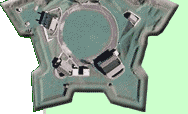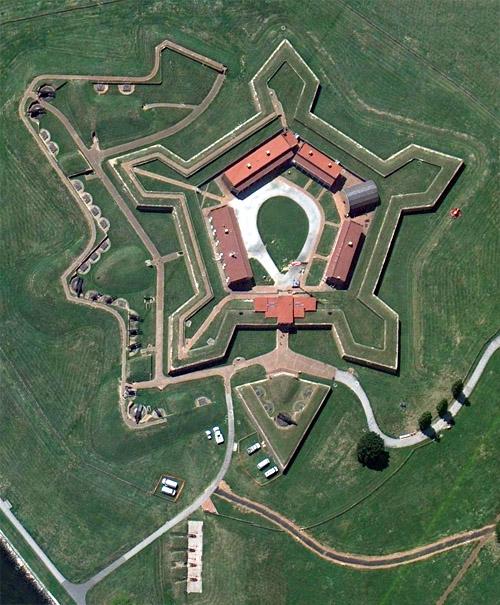
 |
 |
Fort McHenry Baltimore, Maryland |
 |
 |
 |
 |
 |
||
 |
Baltimore has a harbor. By all accounts it's a pretty nice harbor, so naturally the British would have preferred the new USA not possess it. The first defensive structure was built at the current location of Fort McHenry in 1776. The little bit of land that juts out into the entrance of the harbor, then known as Whetstone Point, was developed as a defensive position from 1776 to 1783. The current Fort McHenry was built from 1794 to 1806, and in 1798 was named after James McHenry (1753-1816), a signer of the US Declaration of Independence and Secretary of War under Presidents George Washington (1732-1799) and John Adams (1735-1826). From 1807 to 1814 things were shuffled around some, and the fort was further strengthened. The War of 1812 (1812-1815) broke out in the year you might expect, given the war's name. Britain had been making life difficult for the new United States since the latter was victorious o'er the former in the American Revolutionary War (1775-1783), plus the US just may have had some ambitions regarding all that tantalizingly close Canadian land. Events such as the HMS Leopard firing upon, boarding and removing four British Navy deserters from the USS Chesapeake on June 22 1807, just off the coast of Norfolk, certainly didn't help matters. Though awfully busy with Napoleon (1769-1821) in Europe, Britain said oh all right we'll have a war if you want, and on July 12 1812, 2000 American troops crossed the Detroit River and invaded and occupied a Canadian town with the heroic name of Sandwich. By August, the Americans had retreated back across the river into Detroit, been followed by British, Canadian and Indian troops, and surrendered Detroit and much of the Michigan Territory. Brevet Lieutenant Colonel George Armistead (1780-1818) (uncle of Confederate General Lewis Armistead (1817-1863) who would die at the Battle of Gettysburg (July 1-3 1863)) was in command of Fort McHenry when, on September 13 1814, the Royal Navy began bombarding the fort in hopes of silencing its guns and having free reign over Baltimore. The American defenders' cannon had less range than the British, but the Royal Navy, firing from extreme range to stay out of the American arc of fire, proved unable to hit much of anything important. The bombardment lasted 25 hours and, though pretty ineffective on both sides, was spectacular and great fun to watch, since all of Baltimore's lights had been doused for the occasion: Just ask Francis Scott Key, whose observation of the event inspired his composition of the poem that became the Star Spangled Banner, the US national anthem. Particularly noted in his poem is "the rockets red glare," referring to the British affectation of using pretty, noisy yet wildly innacurate rockets against their enemies. Armistead was painfully aware that Fort McHenry's powder magazine was very vulnerable to mortar fire, which the British were also dropping on his position. One shell actually penetrated into the powder magazine, but for whatever reason failed to explode. Fort McHenry withstood the British naval onslaught, losing only four men: The British gave up and sailed away on the morning of September 14. During the US Civil War (1861-1865) Fort McHenry was used as a prison for both Confederate prisoners of war and many Marylanders who were suspected of Confederate sympathies. Among these devious wretches were Baltimore's Mayor, the entire city council, the police commissioner and, ironically, Francis Scott Key's grandson! More of Fort McHenry's guns were pointed towards the city of Baltimore than towards the water...Baltimore was thought to be just a spark away from complete insurrection against the Union for most of the war. Fort McHenry was massively built up during the First World War (1914-1918) to be used as a hospital for wounded US troops heading home from Europe. The Second World War (1939-1945) pulled the fort back out of retirement to be used as a Coast Guard station, to defend the Chesapeake Bay from the wicked Germans. Fort McHenry was designated a National Park in 1925. In 1939 authorities decided National Park wasn't good enough, so 'twas redesignated as a National Monument and Historic Shrine. In 1959, the first US flag made with 49 stars (thanks, Alaska!) was flown o'er Fort McHenry, and the first 50-star flag was flown over the fort in 1960. The actual flag that flew over Fort McHenry during that fateful bombardment in 1814 is currently on display at the National Museum of American History in Washington DC. It is in extremely fragile condition, and viewable in a darkened room where it is displayed at a comforting, relaxed angle. Fort McHenry is one of the eastern US' major tourist attractions. I visited the fort in 2012, won't you please visit my Fort McHenry Page in this site's Starforts I've Visited section? |
 |
 |
||
|
|
|||||||
Info Source 1 Info Source 2 Info Source 3 Info Source 4 Info Source 5 Info Source 6 Info Source 7 Info Source 8 Info Source 9 Info Source 10 Info Source 11 Info Source 12 Info Source 13 Info Source 14 Info Source 15 Thanks to Google Maps for the image! ©2010 starforts.com |
 |